5+5 Activity Guide, CardEd, Education, English, Mathematics, MY Classroom
5 + 5 Activity Resource (No. 7) – 5 Independent & 5 Cooperative Learning Activities to Try
Week 7 is upon us! Malaysia has completed a u-turn on MCO and we will have a significant relaxing of lock-down rules from Monday 4th. That said, schools remain closed so children will continue to learn at home for the time being. To support this, here is our 7th weekly 5+5 Activity Guide. I have created a new 5+5 section on the website so that these posts are easy to find.
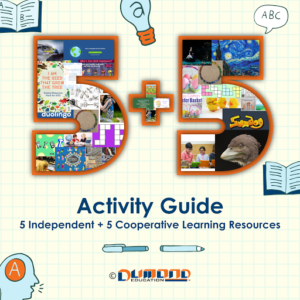
Independent Learning Activities
English – Reading
Collins have provided free access to many of their levelled readers and worksheets to accompany them. A fantastic resource for younger readers.
As we know, there is no better example we can set for our children than to be readers ourselves. Parents and carers, you may enjoy taking part in The Big Book Weekend which features a 3 day line-up of authors being interviewed about their work. Why not, as a family, listen to the interview with Michael Morpurgo on Friday at 3pm (UK)?
It is suitable for children aged 7+. There are many great benefits to be derived from such an extended listening task. Have a chat with your child afterwards to determine how well-developed his/her listening comprehension is. Was (s)he able to follow the conversation? Can (s)he retell some of the pertinent details?
There are lots more stories to be found on Free Children Stories, including some for middle grade readers. A couple of the stories for younger children are narrated if you decide to target listening comprehension.
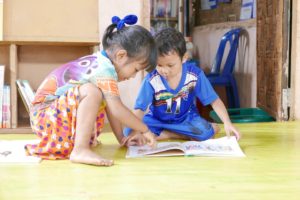
Maths – Calculating/Problem-Solving
As you know, I love to include maths challenges in my weekly 5+5 Activity Guides. One of my favourite challenges is the Four Fours Puzzle. Are you familiar with it? It is a brilliant activity for each member of the family to try. Who will come up with the most solutions by the end of the week?

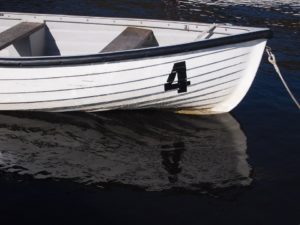
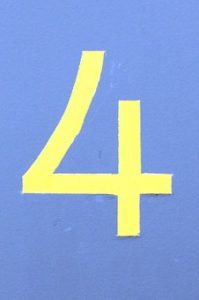
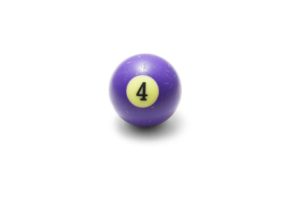
Basically, you must use exactly four 4s to form every integer from 0 to 50 (or beyond), using only the operators +, -, x, /, () (brackets), . (decimal point), x2 (square), square root and ! (factorial).
For example: 0 = 44-44
Try it this week and post a comment to let me know how you get on!
STEM & History
Take a look at Stem in 30 for tasks and challenges set by the Smithsonian National Air and Space Museum. There are various subjects and topics on the schedule. The most recent task was launched on April 30th and looks at how the airplane contributed to the Allied victory over the Axis powers in World War II. The episode feature collections and stories from the World War II Museum in New Orleans and showcases students’ interviews with veterans. To follow, there will be a mission debrief, featuring a live chat and the opportunity to ask questions, on May 7th at 1.00 pm EDT.

This is timely of course as we mark the 75th anniversary of VE Day on the 8-10th May. Does your child know what VE Day is?
-
You can learn more about VE Day here.
-
Uncover some of the background to the war on National Geographic Kids.
-
Find a timeline and investigate particular events on Ducksters and on DK .
-
The Imperial War Museum documents how life was in Britain during the war.
Can you find any information about how life during the war years was where you live? Until I moved to Malaysia and visited some of the museums here, I was largely unaware of the extent of the devastation caused by the Japanese occupation during WW2. Find a timeline of events as they unfolded and read stories from some of the survivors here.
STEM – Physics
On the theme of science, here is another fantastic discovery I have made. Lift Lessons is offering free access until August to their site which focuses on teaching students science vocabulary.
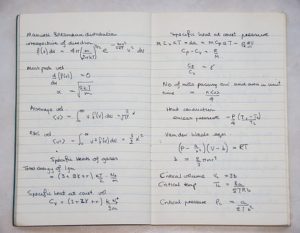
There are two vocabulary levels – introductory and challenge. The site utilises proven study techniques, e.g.retrieval practice to support children’s learning. Why not sign your child up and have them dedicate a few minutes each day to boosting their language of science?
Art
Twitter users reading this may have discovered the #drawwithrob. Rob uploads lovely videos to teach children how to draw. Share your child’s creations with Rob on Twitter or on any of his other social media pages.
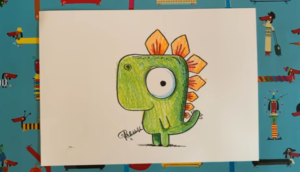
Cooperative Learning Activities
English – Oracy and More!
As a new month has just begun, I shared several planning calendars in my blog on Friday 1st. See here. These include art, mindfulness, maths, STEM and P.E. resources.
I also created a Conversation Calendar for May and would urge you to download it. Use it throughout the month to boost your child’s speaking and listening skills. There is a growing focus on the importance of oracy in schools. This is an area that is often overlooked with the focus on reading and writing. It is one of the simplest areas to boost at home and something no resources are required for. Give it a go today!
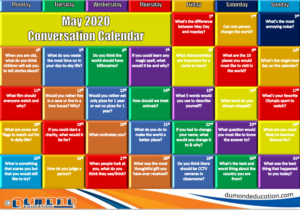
Some readers of this blog are parents of children learning English as an additional language. I would like to draw your attention to an excellent website called Anglomaniacy that’s packed with games and resources for teaching grammar, vocabulary and expression. Children who are native speakers will also gain lots from using this website. Have a look at the vocabulary activities.
Some of the spelling tasks for example will be really useful for them. The guessing games also support spelling and vocabulary and are great for young learners both EAL and native speakers alike. There is a memory match games section and such tasks are good tests of our working memory, i.e., the amount of material we can hold in our mind and process all at once.
For those readers in Ireland or others who have children studying MFL, why not see if they can translate the image shown and tell you the word for it in the language they are studying?
Geography – Wonders of the World
On the subject of language and discussion, here is another topic for you. Do you know what the most popular tourist destinations in the world are? How many must-see places can you think of?

Have a chat with your child. When lock-down is all over and we once again can travel, where would they like to go? Can (s)he create a travel guide for that place? What would they do there? How would they get there? Where would they stay? What local foods would (s)he make sure to try?
Perhaps (s)he can’t simply choose one place. Why not have him/her create their own travel collage or scrapbook?

Here are the top 50 destinations in the world according to a 2019 survey conducted by Big Travel. Check out these amazing photographs of stunning places. Which of these places would your child personally like to photograph? Can your child create a piece of art based on one of these images? Enjoy 25 amazing wonders of the world from the comfort of your own home.
In addition, you may wish to use some of these resources:
-
Here are some worksheets on the travel theme.
-
Access others here on ESL Kids.
-
Use this prompt sheet to discuss world landmarks.
-
Try this conversation-boosting travel board-game.
Where will you go from the comfort of your own home?
Make the World a Better Place Project – Debate/ Geography/ Art & Craft/ Design & Technology
For now, we are unable to travel too far. This gives us lots of time to focus on where we live, what our community is like and any changes we would like to see in our area.Those already using our Conversation Calendar will know Saturday’s question was, ‘Can one person change the world?’
Instead of focusing on one person changing the world, this cooperative task asks families to consider what you can do. Have each person to think about how (s)he could become a catalyst for change in the community. What things can (s)he do right now to make the community better? What ideas do they have that can be implemented once movement is not so restricted? How long a list can your family draw up?
Here are 60 ideas for comparison purposes.

Based on this theme, if you were designing your own city, what would it look like and what would you include? Why not create your own town or city as a family using the building templates this architecture firm has shared?
What challenges do you think would be involved in building a city from scratch? What opportunities would such a challenge present? Why might a new city be developed?
Did you know that in recent times over 100 cities have sprung up across Africa and Asia? Have a look at this brilliant article and check out the satellite images of the development of 4 cities. A fascinating investigation for budding geographers and town planners out there.
Investigate Where our Food Comes from – Personal and Health Education / Geography
As always, there are lots of special awareness days and celebrations that fall this week. Saturday, May 9th is World Fair Trade Day. Learn more about fair trade here and discover what fairtrade does.

Why not take part in the challenge to create a fair trade poster using Canva?
Investigate where foods in the home have come from. Use a globe/map to identify where each country is. What is the items that has travelled the furthest to reach your home? Discuss the problems associated with the import of food. Learn about the journey of different foodstuffs to our homes here.
Challenge: Can you cook a family meal using either an ingredient produced or grown locally or using a fairtrade ingredient?
CardEd
As always, I have created a free weekly CardEd Activity pack for you. Use these to boost problem-solving, thinking skills, maths and English. These are really useful to use with children learning English as an additional language also as they include lots of idioms and phrases, the meaning of which is not always immediately clear.

 I hope this week’s 5+5 Activity Guide helps you in getting ready for the week ahead and in finding ideas to supplement those provided by your child’s teacher.
I hope this week’s 5+5 Activity Guide helps you in getting ready for the week ahead and in finding ideas to supplement those provided by your child’s teacher.
Before I sign off, did you know today is World Laughter Day? Why not enjoy a few jokes as a family this evening. Please share your best joke with us to make someone smile today!
Take care and stay safe all!
